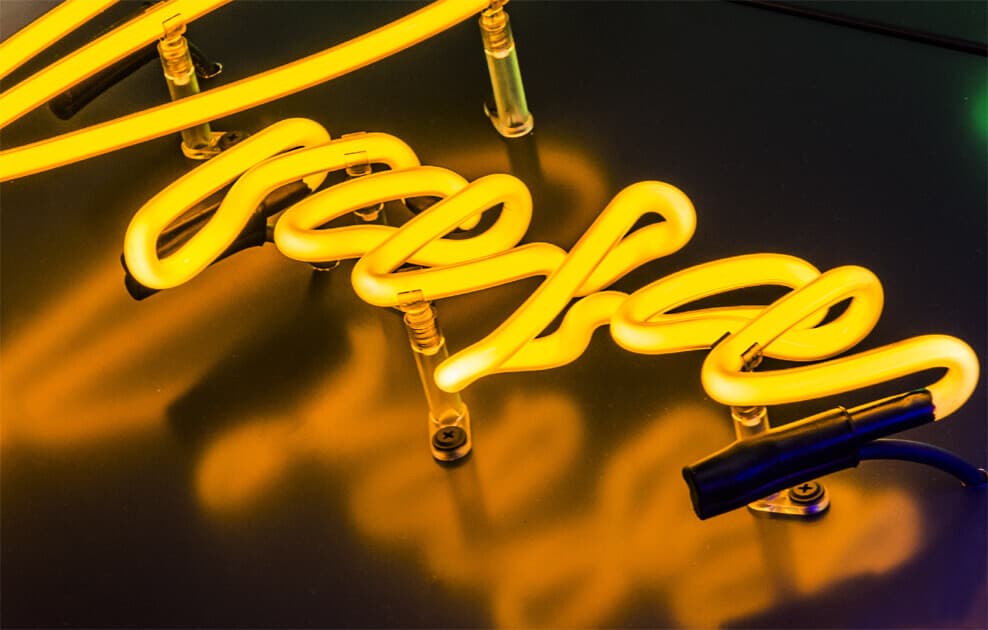Neons play a significant role nowadays. They are visible in the streets of big cities, small towns and villages. These neon lights can take the form of artistically curved shapes and letters. They add a colourful, glowing effect to each item that is made of them. A glowing logo, banner, sign on a restaurant, cinema or clothing store attract the attention of passers-by and encourage them to use the services or make pur-chases. Neon lights are an eye-catching idea that has been perfect for the advertis-ing industry from the very beginning.
The beginnings of the neon career
The very word "neon" is derived from the word "neos" and means "new gas". Neon occurs naturally in the atmosphere, but in negligible amounts. Neon gas was dis-covered in 1898 by William Ramsay and Morris Travers. However, it was George Claude who was the first to create the neon. He combined electric gases and then passed an electric current through them. The result of this experiment was dis-charge, visible in different colours. When the neon maker realized that glass tubes can be twisted in different ways, into different positions, he took part in an exhibition in Paris in 1910. It was the beginning of the glory of neon lights.
What is neon? How is it made?
Neon lights are glass tubes filled with inert gases. This fact means that the neon lights do not react with other chemicals. As soon as the gas fills the tube, several electrodes are connected to the end, at which point the energy transported by the volts contributes to the boiling of the atoms inside the gas.
What is the process of making neon lights?
The very process of creating neon lights consists of several significant steps and is a time-consuming and long-term process. As the first step, we always choose the project that we want to create. The next step is to print it on white, fireproof paper, on which we carefully mark the places where the material will need to bend. Then we can start shaping our tubes. This process takes place at a temperature of 800 ° C - 900 ° C, which is possible thanks to a tool called a ribbon burner. As soon as the glass becomes soft, and this happens after approximately 30 seconds, it is time to bend the glass to the desired shape. Then, after the melting and bending process, we start joining the electrodes at the end of each tube. Now we're hitting each of the tubes with a 20,000 volt electron bombarder. Towards the end, we must not forget to inject the gas used to make the element, and then we must stick the neon to another element made of wood or plastic. What else needs to be done? Turn on the light and enjoy the completed task. This is the last stage that allows us to verify the order we have made.
What colour is the neon?
Classic real neon is orange-red in colour. Red is visible in its pure form and in a transparent glass tube. Neon, whose colour is not classic red, informs us that it does not contain gas neon. It is generally known that noble gases glow in their own col-our when exposed to high voltage. So helium glows pink, krypton turns yellow-green, xenon turns lavender, and argon then turns light blue. Radon is also a noble gas, but it is the only one that does not react to electricity by shining with colour, and thus it is the only noble gas not used in neon.
More neon shades can be obtained by applying a variety of glass coatings that are used for the pipes. Therefore, when switched off, neon lights are white or colourful - in the latter case they are coloured. When delving further into the topic of neon col-ours, it is worth noting that classic red and classic blue neon are made of transpar-ent glass and, respectively, neon glass, as well as argon. However, all other colours can be obtained by manipulating the glass using fluorescent powders such as pink, purple or green neon as well as by tinting the glass.
Neon is an art in itself
Ever since the nineteenth century, neon lighting has spread around the world, many artists have become interested in its use in art. Neon lights began to be used in movies, TV programs and in modern art. Julia Bickerstaff, a famous neon design-er, has gained great popularity in the world. She made signs for Star Trek movies and for the famous hotel in Dubai. Bruce Nauman is another famous personality, a veteran among neon artists. He created dozens of designs and collections that he presented as his art in renowned, famous museums around the world.
Neons are certainly more than just "lights". It is real art, which nowadays also occu-pies an excellent position in the advertising industry.

